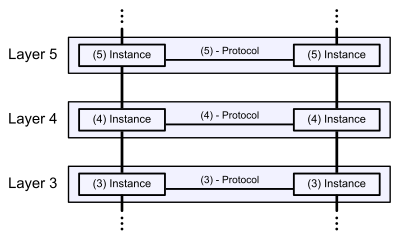
Back OSI-model Afrikaans نموذج الربط البيني للأنظمة المفتوحة Arabic Modelu OSI AST OSI modeli Azerbaijani Эталонная мадэль OSI Byelorussian Мадэль OSI BE-X-OLD OSI модел Bulgarian ওএসআই মডেল Bengali/Bangla OSI model BS OSI Catalan
| OSI model by layer |
|---|
The Open Systems Interconnection (OSI) model is a reference model from the International Organization for Standardization (ISO) that "provides a common basis for the coordination of standards development for the purpose of systems interconnection."[2] In the OSI reference model, the communications between systems are split into seven different abstraction layers: Physical, Data Link, Network, Transport, Session, Presentation, and Application.[3]
The model partitions the flow of data in a communication system into seven abstraction layers to describe networked communication from the physical implementation of transmitting bits across a communications medium to the highest-level representation of data of a distributed application. Each intermediate layer serves a class of functionality to the layer above it and is served by the layer below it. Classes of functionality are realized in all software development through all standardized communication protocols.
Each layer in the OSI model has well-defined functions, and the methods of each layer communicate and interact with those of the layers immediately above and below as appropriate.
The Internet protocol suite as defined in RFC 1122 and RFC 1123 is a model of networking developed contemporarily to the OSI model, and was funded primarily by the U.S. Department of Defense. It was the foundation for the development of the Internet. It assumed the presence of generic physical links and focused primarily on the software layers of communication, with a similar but much less rigorous structure than the OSI model.
In comparison, several networking models have sought to create an intellectual framework for clarifying networking concepts and activities,[citation needed] but none have been as successful as the OSI reference model in becoming the standard model for discussing and teaching networking in the field of information technology. The model allows transparent communication through equivalent exchange of protocol data units (PDUs) between two parties, through what is known as peer-to-peer networking (also known as peer-to-peer communication). As a result, the OSI reference model has not only become an important piece among professionals and non-professionals alike, but also in all networking between one or many parties, due in large part to its commonly accepted user-friendly framework.[4]

- ^ "X.225 : Information technology – Open Systems Interconnection – Connection-oriented Session protocol: Protocol specification". Archived from the original on 1 February 2021. Retrieved 10 March 2023.
- ^ ISO/IEC 7498-1:1994 Information technology — Open Systems Interconnection — Basic Reference Model: The Basic Model. June 1999. Introduction. Retrieved 26 August 2022.
- ^ "What is the OSI Model?". Forcepoint. 10 August 2018. Retrieved 20 May 2022.
- ^ Tomsho, Greg (2016). Guide to Networking Essentials (7th ed.). Cengage. Retrieved 3 April 2022.